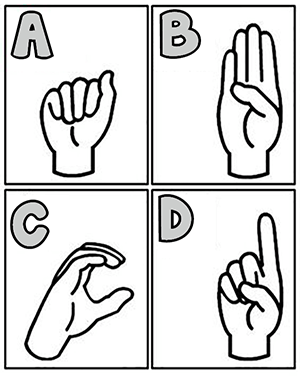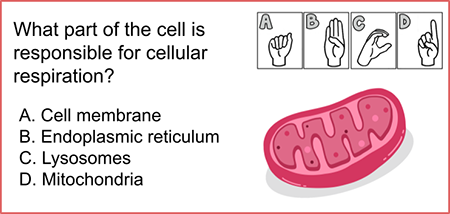
Many teachers have access to high tech tools that employ clickers and other devices to engage students during presentations. Peardeck and Nearpod are also popular apps for students to become more immersed in classroom lectures.
I tend to take a more low-tech approach. Embedded within my presentations are practice questions, or refocus questions. Without clickers, my students use simple American Sign Language to answer questions.
The advantage is that every student gets to weigh in, not just the one you call on. Plus, students get a kinesthetic aspect added to their lesson.
How Does It Work?
After presenting slides on the cell, you can place a slide that asks a multiple choice question. Students answer by signing A, B, C, or D. I can even quickly give feedback with a nod or other indication to students who have it correct. This can also help with shy students or reduce anxiety about being called to answer a question.

You can also use true / false questions where students give you thumbs-up or thumbs-down. Yes/No signs can also be used.
I have also incorporated other signs to help with communication. My students know that to request to go to the bathroom, they give me the sign for it, which reduces class interruptions because they can be discreet.
I’ve also added signs for biological terminology, and even have students create their own. For mitochondria, students usually come up with a gesture that looks like an explosion (for “powerhouse”.) Many biological terms do not have actual ASL signs, and I’ve had deaf students in my class to help with some actual interpretations. There are resources online if you want to add more legitimate signs. This video is great for basic signs that you might use frequently. My goal is to get kids moving a little and provide other communication options for students that don’t like to speak in class. I often use the “more” sign if I want students to elaborate when they answer spoken questions.
You can also use true / false questions where students give you thumbs-up or thumbs-down. Yes/No signs can also be used.
I have also incorporated other signs to help with communication. My students know that to request to go to the bathroom, they give me the sign for it, which reduces class interruptions because they can be discreet.
I’ve also added signs for biological terminology, and even have students create their own. For mitochondria, students usually come up with a gesture that looks like an explosion (for “powerhouse”.) Many biological terms do not have actual ASL signs, and I’ve had deaf students in my class to help with some actual interpretations. There are resources online if you want to add more legitimate signs. This video is great for basic signs that you might use frequently. My goal is to get kids moving a little and provide other communication options for students that don’t like to speak in class. I often use the “more” sign if I want students to elaborate when they answer spoken questions.
You can make your own signs to post in the classroom or buy them from Amazon.
Final Note About Technology
I’m not against clicker systems, but I don’t have them in my classroom and they are expensive. Nearpod systems are great, but sometimes I lose my students when they open up their Chromebook. It’s almost like they disappear behind the screen. Also, those types of presentations can be time consuming to make. The sign language is a low tech and easy way to drive engagement in the classroom.

